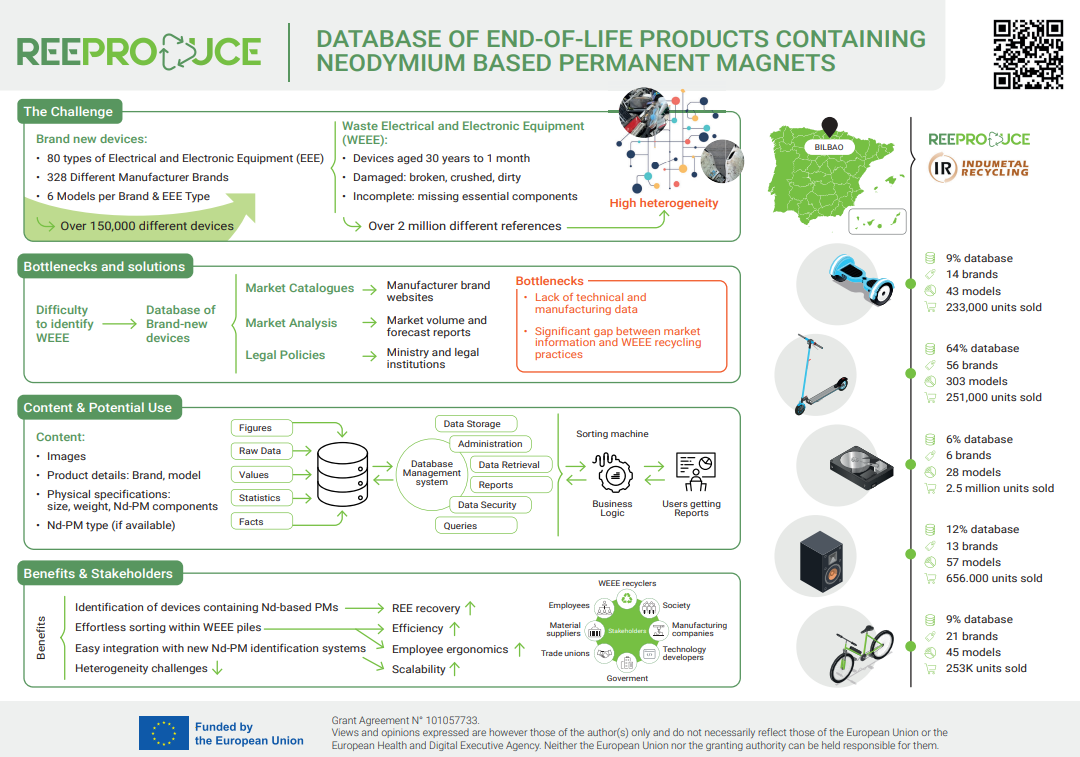10 Apr 2025
Discover the REEPRODUCE database of End-of-Life products containing Neodymium-based permanent magnets.

Explore the infographic here.
In the framework of the REEPRODUCE project, Indumetal Recycling is developing a database containing end-of-life (EoL) products containing Neodymium-based (Nd) permanent magnets (PM). The aim of this database is to establish a comprehensive inventory of products containing Nd-based PMs, providing a complete overview of their presence and distribution in EoL products.
In the initial stage, Indumetal estimated the existing devices, considering not only the device type but also the brand and model, as these factors play a crucial role in accurate recognition. On average, there are 80 types of devices, 328 Electric and Electronic Equipment (EEE) manufacturers brands, and proximately 6 models per brand and EEE type, totalling around 150,000 different devices that will enter the WEEE stream at the end of their life.
However, to make this estimation Indumetal considered the heterogeneity caused by different removal processes, which result levels of damage to WEEE and complicate the recognition process. This includes factors related to the removal process of electricity and electronic equipment (EEE) – from households to collection points and vice versa – which result in varying levels of damage to WEEE, making the recognition step more challenging.
To address this challenge, Indumetal decided to work with a database of brand-new devices. To enhance this effort, they have used market catalogues, market analysis, and legal policy information to compile a comprehensive list of devices containing Nd-based permanent magnets. However, during the process they encountered bottlenecks such as the lack of technical manufacturing data, making it difficult to identify the type of magnet in each device, and a significant gap between market information and WEEE recycling practices.
In general, the database consists of a comprehensive collection of images alongside detailed product information, including brand and model specifications. Additionally, it incorporates physical attributes such as size, weight, and the presence of Nd-based permanent magnet components. Then, whenever possible, the database identifies the specific type of Nd-PM used in each device, enhancing its value for analysis and classification.
The database is built using sales data from Spain in 2024 by now. This data represents the percentage distribution of each device, shaping the database’s composition which includes the number of brands and models collected, and the total sales figures in Spain for 2024.
To conclude, the development of this database provides significant benefits for a wide range of stakeholders including WEEE recyclers, manufacturing companies, or technology developers, among others. By increasing the recovery of REEs, this process enhances resource efficiency and supports the circular economy. The ability to easily sort Nd-PM-containing devices from the broader WEEE pile significantly improves operational efficiency while also reducing physical strain on employees, leading to better workplace ergonomics. Additionally, the system’s scalability ensures seamless integration with future Nd-PM identification technologies, reducing the challenges associated with material heterogeneity.